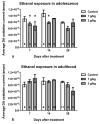Reduced dopamine release in the nucleus accumbens core of adult rats following adolescent binge alcohol exposure: age and dose-dependent analysis
- PMID: 25116483
- PMCID: PMC4351806
- DOI: 10.1007/s00213-014-3712-1
Reduced dopamine release in the nucleus accumbens core of adult rats following adolescent binge alcohol exposure: age and dose-dependent analysis
Abstract
Rationale: Alcohol use in adolescence is one of the most significant predictors of alcohol dependence in adulthood, yet the neurochemical mechanisms underlying this heightened vulnerability remain unknown. Whereas research has focused on characterizing adaptations in the mesolimbic dopamine (DA) system following ethanol exposure in adolescence, whether these changes persist into adulthood has yet to be determined.
Objectives: The objective of this study is to investigate the effects of binge-intermittent ethanol administration in adolescence (P30-50) or early adulthood (P60-80) on DA in the nucleus accumbens (NAc) core after an ethanol challenge in adulthood following a period of abstinence.
Methods: Male Sprague Dawley rats (n = 160) were administered intermittent ethanol injections, 1 or 3 g/kg, intraperitoneally (i.p.) every other day for 20 days starting on either P30 or 60. Following an ethanol-free period of either 7, 14, or 28 days, we measured DA efflux following an ethanol challenge (3 g/kg, i.p.) using electrochemical recording electrodes bilaterally implanted into the NAc core.
Results: Moderate-dose ethanol administration (1 g/kg, i.p.) during adolescence significantly decreased ethanol-evoked DA release in adulthood at 7 and 14 days, but not 28 days, following pretreatment exposure compared to saline controls. Relative to rats pretreated with ethanol in adulthood, moderate-dose ethanol in adolescence significantly reduced DA efflux at all time points measured. Additionally, adult rats pretreated with high dose ethanol administration (3 g/kg, i.p.) displayed significantly decreased DA compared to adolescents after 28 days of withdrawal.
Conclusions: Binge-intermittent ethanol administration during adolescence may induce age-dependent neuroadaptations in the mesolimbic DA system compared to ethanol-treated adults during protracted ethanol withdrawal.
Figures




Similar articles
-
Adolescent binge-like alcohol alters sensitivity to acute alcohol effects on dopamine release in the nucleus accumbens of adult rats.Psychopharmacology (Berl). 2016 Feb;233(3):361-71. doi: 10.1007/s00213-015-4106-8. Psychopharmacology (Berl). 2016. PMID: 26487039 Free PMC article.
-
Adolescent Intermittent Ethanol (AIE) Enhances the Dopaminergic Response to Ethanol within the Mesolimbic Pathway during Adulthood: Alterations in Cholinergic/Dopaminergic Genes Expression in the Nucleus Accumbens Shell.Int J Mol Sci. 2021 Oct 29;22(21):11733. doi: 10.3390/ijms222111733. Int J Mol Sci. 2021. PMID: 34769161 Free PMC article.
-
Long-term effects of adolescent versus adult nicotine self-administration on cholinergic modulation of dopamine in the nucleus accumbens core.Drug Alcohol Depend. 2025 Mar 1;268:112555. doi: 10.1016/j.drugalcdep.2025.112555. Epub 2025 Jan 15. Drug Alcohol Depend. 2025. PMID: 39881470
-
Changes in Brain Dopamine Extracellular Concentration after Ethanol Administration; Rat Microdialysis Studies.Alcohol Alcohol. 2022 Mar 12;57(2):165-175. doi: 10.1093/alcalc/agab072. Alcohol Alcohol. 2022. PMID: 34693981 Review.
-
Recent Perspectives on Sex Differences in Compulsion-Like and Binge Alcohol Drinking.Int J Mol Sci. 2021 Apr 6;22(7):3788. doi: 10.3390/ijms22073788. Int J Mol Sci. 2021. PMID: 33917517 Free PMC article. Review.
Cited by
-
Effects of Ethanol Exposure During Adolescence or Adulthood on Locomotor Sensitization and Dopamine Levels in the Reward System.Front Behav Neurosci. 2020 Mar 6;14:31. doi: 10.3389/fnbeh.2020.00031. eCollection 2020. Front Behav Neurosci. 2020. PMID: 32210774 Free PMC article.
-
Reward-centricity and attenuated aversions: An adolescent phenotype emerging from studies in laboratory animals.Neurosci Biobehav Rev. 2016 Nov;70:121-134. doi: 10.1016/j.neubiorev.2016.08.015. Epub 2016 Aug 11. Neurosci Biobehav Rev. 2016. PMID: 27524639 Free PMC article. Review.
-
Sex-specific decision-making impairments and striatal dopaminergic changes after binge drinking history in rats.Front Pharmacol. 2023 Jan 16;14:1076465. doi: 10.3389/fphar.2023.1076465. eCollection 2023. Front Pharmacol. 2023. PMID: 36726581 Free PMC article.
-
Juvenile Traumatic Brain Injury Increases Alcohol Consumption and Reward in Female Mice.J Neurotrauma. 2016 May 1;33(9):895-903. doi: 10.1089/neu.2015.3953. Epub 2015 Oct 8. J Neurotrauma. 2016. PMID: 26153729 Free PMC article.
-
Gender Differences in Risk Factors for Adolescent Binge Drinking and Implications for Intervention and Prevention.Front Psychiatry. 2017 Dec 22;8:289. doi: 10.3389/fpsyt.2017.00289. eCollection 2017. Front Psychiatry. 2017. PMID: 29312017 Free PMC article. Review.
References
-
- Administration SAaMHS . Results from the 2011 National Survey on Drug Use and Health: Summary of National Findings NSDUH Series H-44. Substance Abuse and Mental Health Services Administration; Rockville, MD: 2012.
-
- Alaux-Cantin S, Warnault V, Legastelois R, Botia B, Pierrefiche O, Vilpoux C, Naassila M. Alcohol intoxications during adolescence increase motivation for alcohol in adult rats and induce neuroadaptations in the nucleus accumbens. Neuropharmacology. 2013;67:521–531. - PubMed
-
- Badanich KA, Adler KJ, Kirstein CL. Adolescents differ from adults in cocaine conditioned place preference and cocaine-induced dopamine in the nucleus accumbens septi. European Journal of Pharmacology. 2006;550:95–106. - PubMed
-
- Badanich KA, Maldonado AM, Kirstein CL. Chronic Ethanol Exposure During Adolescence Increases Basal Dopamine in the Nucleus Accumbens Septi During Adulthood. Alcoholism: Clinical and Experimental Research. 2007;31:895–900. - PubMed
-
- Blaha CD. Evaluation of stearate-graphite paste electrodes for chronic measurement of extracellular dopamine concentrations in the mammalian brain. Pharmacol Biochem Behav. 1996;55:351–364. - PubMed
Publication types
MeSH terms
Substances
Grants and funding
LinkOut - more resources
Full Text Sources
Other Literature Sources

